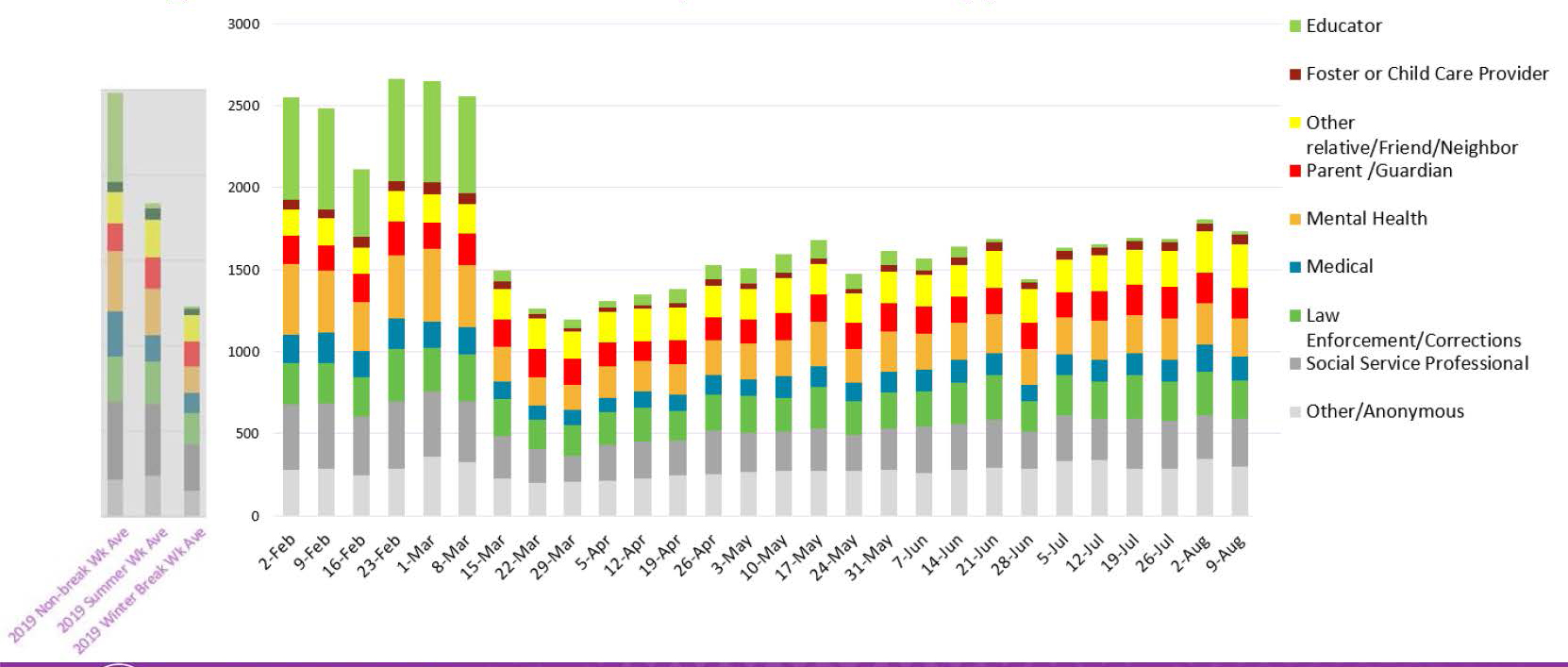The Washington State Department of Children, Youth, and Families (DCYF) supports families in crisis and part of that work requires responding to allegations of abuse and neglect. Reporters of abuse primarily are mandated reporters in fields that work directly with children, but community members and neighbors also call the state’s End Harm line to report suspected child abuse or neglect. The agency’s intake line receives over 120,000 calls annually. About 40% of those calls meet the statutory threshold requiring our child welfare staff to visit a home to assess a child’s safety. DCYF does not consider FAR as investigating abuse/neglect, but we can respond with either an investigation or FAR. In CY 2019, 40% of all CPS intakes were screened in and required a response (46,626 screened-in / 114,902 CPS intakes).
Children out of sight of the general public, lack of in-person school, less activity and engagement with community and family as a result of the COVID-19 pandemic means some abuse may not be reported. DCYF saw a significant decline in the number of reported calls into the agency’s intake line, most especially early in the public health emergency when schools closed.
On average, the intake line sees a decline in calls around the summer months when school is out of session and children are on break, and an even greater decline during the December holiday break. As illustrated in the chart below, the initial drop in maltreatment intakes weekly called into the state hotline following the governor’s initial Stay Home, Stay Healthy order was similar to the dip seen in December holiday break of most years. Intake numbers have recovered a bit, and are now up higher than what we typically see in summer months.

Washington’s trend is similar to what child welfare agencies across the country have seen since the start of the public health emergency. A recent report by Chapin Hall at the University of Chicago found that the alarming rise in unemployment and potentially persistent economic downturn likely pose a greater threat to children than the temporary interruption of their exposure to mandated reporters. They recommend that child welfare agencies:
- Refine child maltreatment categories to distinguish and address poverty-related neglect from child endangerment or abuse.
- Broaden the array of community-based supports and partner with families directly.
- Leverage technology to improve access to needed supports and services.
- Create alternative pathways to enhance the ways in which mandated reporters can support families.
- Expand the responsibility for child and family well-being beyond the child welfare system.
DCYF’s Office of Innovation, Alignment, and Accountability examined the last recession to gain clues as to what we might expect in the wake of the current economic downturn in terms of impacts on child maltreatment. The increases in maltreatment in the years following the last recession were most pronounced in the areas of the state that had the highest baseline rates of maltreatment. Unfortunately, those increases were steep and persistent.
DCYF’s Plan
There are number of actions the agency has taken to address the decline in calls and potential impacts of the public health emergency and the recession on child maltreatment:
- Support mandated reporters by:
- Strengthening relationships with medical professionals and partner to assessing families’ needs as clinicians witness the decline in routine medical visits.
- Create a training for mandated reporters, educators and child instructors to recognize signs of abuse and neglect in the virtual environment.
- Creating a directory of supportive resources (in multiple languages) for use by mandated reporters and the public.
- Build awareness on public information platforms.
- Support families and communities by:
- Expanded outreach to community partners by facilitating virtual meetings to address concerns within their communities.
- Engaging the community through public service announcements.
- Expand access to preventive services and supports, especially in those areas of the state with high baseline rates of child maltreatment.
- Use data to monitor intake and child injury data in order to quickly identify potential increases and allocate responsive resources.
Resources
DCYF has collaborated with RDA to produce a dashboard of child welfare and healthcare data to monitor for potential increases in severe child injury and other impacts on the children, youth, and families we serve. See the Child Welfare and Health Service Trends in Washington State dashboard.
Chapin Hall’s report COVID-19 and Child Welfare: Using Data to Understand Trends in Maltreatment and Response.

